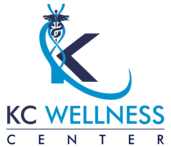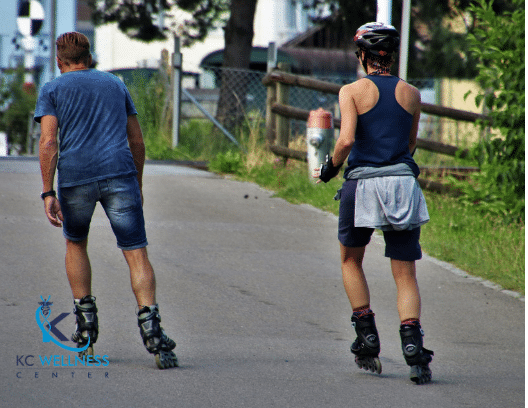For those looking to exercise regularly but suffering from chronic joint pain, roller skating may be an excellent option to consider. Compared to more mainstream forms of exercise like running or jogging, roller skating is a great alternative, as it provides the same aerobic benefits while causing less joint pain. Plus, if you have kids, it’s a great way to get active outdoors as a family. Read on to learn more about the benefits of roller skating, and consider adding this fun activity to your workout regime for National #RollerSkatingMonth.
Is Roller Skating Good Exercise?
Absolutely—roller skating is not just a recreational activity, it’s a full-body workout that offers both cardiovascular and muscular benefits. For individuals with chronic joint pain who want to stay active without aggravating their symptoms, roller skating can be a fantastic low-impact alternative to more jarring exercises like running or high-intensity aerobics. It provides an effective way to boost heart health, improve balance, build endurance, and burn calories—all while being gentle on your joints.
Health Benefits of Roller Skating
Roller skating is more than just a nostalgic pastime. It’s a highly effective form of aerobic exercise that offers a wide range of physical and mental health benefits. Whether you’re looking to improve cardiovascular health, build muscle strength, or simply stay active without placing too much strain on your joints, roller skating is a fantastic option to consider.
1. Low-Impact on Joints
Unlike high-impact activities such as running or jumping, roller skating is gentler on the knees and hips. This makes it an ideal choice for individuals who suffer from chronic joint pain, arthritis, or other mobility challenges but still want to stay active. The smooth, gliding motion of skating minimizes jarring impact, allowing for movement without stressing the joints.
2. Full-Body Muscle Engagement
According to the Roller Skating Association International, roller skating activates several major muscle groups. Your lower body powers your stride, your core helps maintain balance, and your arms add momentum and coordination. Over time, skating can help improve muscle tone, strength, and overall endurance across the entire body.
3. Excellent Cardiovascular Exercise
Skating isn’t just fun, it’s also a great cardio workout. In just 30 minutes, your heart rate may rise to 148 beats per minute or more, delivering cardiovascular benefits similar to cycling or jogging. According to Diet and Fitness Today, a 190-pound male can burn approximately 530 calories in just half an hour of skating.
If you extend your session to a full hour, the calorie burn increases significantly, about 1,060 calories for males and around 909 calories for females, depending on body weight and how vigorously you’re skating. This makes roller skating one of the most enjoyable and effective ways to boost heart health while burning serious calories.
4. Boosts Mental Well-Being
The rhythmic, flowing motion of skating can also support mental health. As with most aerobic exercise, roller skating triggers the release of endorphins, helping to reduce stress, improve your mood, and increase mental clarity. Whether you skate solo or with others, it’s a great way to elevate your emotional well-being.
5. A Fun and Family-Friendly Activity
Another unique benefit of roller skating is that it doesn’t feel like a workout. You can skate at the park, a local rink, or even indoors if space allows. It’s an especially great way to stay active with your kids or friends, combining fitness with fun and social interaction.
6. Minimizes Injury Risk with Proper Gear
While skating is relatively low-impact, injuries can still happen—most commonly to the wrists during falls. However, wearing protective gear can dramatically reduce your risk. According to the American Orthopaedic Society for Sports Medicine, wrist guards alone can cut the risk of wrist injuries by 87%. Add a helmet, knee pads, and elbow pads for even greater protection.
Get Started with a Personalized PRP Treatment Plan
In honor of National #RollerSkatingMonth, consider giving roller skating a try. It’s a low-impact, calorie-burning, muscle-building, mood-lifting activity that’s as enjoyable as it is effective. Whether you’re looking for a new fitness routine or a fun way to stay active with your family, roller skating might just be the exercise your body, and joints, have been waiting for.
And if you’re managing persistent joint pain or looking to enhance your recovery and mobility, lifestyle changes like skating can be even more powerful when paired with supportive treatments. At KC Medical & Wellness Center, we offer regenerative options such as Platelet-Rich Plasma (PRP) therapy, bioidentical hormone replacement, IV vitamin therapy, and more—all designed to help your body heal naturally and move with greater ease.
So lace up, stay active, and know that if your joints need a little extra support, we’re here to help you roll toward better health. Contact us today!
Those who suffer from persistent joint pain may also benefit from platelet-rich plasma therapy. To learn more, call us at (816) 214-5276 or visit https://bit.ly/2ImSbAn.
Frequently Asked Questions
Is roller skating safe for people with joint pain?
Yes, when done correctly and with the right precautions, roller skating can be a safe and effective form of low-impact exercise for individuals with joint pain. Unlike running or jumping, skating involves smooth, gliding motions that place less stress on the knees, hips, and ankles, making it easier on the joints.
What precautions should I take before starting roller skating with joint issues?
Start slowly and warm up your muscles before skating. Always wear protective gear including wrist guards, knee pads, elbow pads, and a helmet to reduce your risk of injury. If you’re new to skating or unsure about your balance, consider starting at an indoor rink or with a trainer who can offer support.
Can roller skating actually improve joint health over time?
While skating won’t cure joint issues, it can help improve overall joint health by strengthening the muscles that support your joints, improving balance, and enhancing flexibility. As a weight-bearing yet low-impact exercise, it can also help maintain healthy bone density and circulation.

Dr. Rahul Kapur, M.D. is a board-certified family medicine physician with a dedicated passion for integrative medicine and a deep knowledge of functional medicine. He was named intern of the year at Wesley Medical Center in Wichita, KS, and has been practicing as a hospitalist for over a decade. He has successfully helped many patients in Kansas City with his specialized IV bags, ketamine therapy, hormone optimization and weight loss therapy methods.

